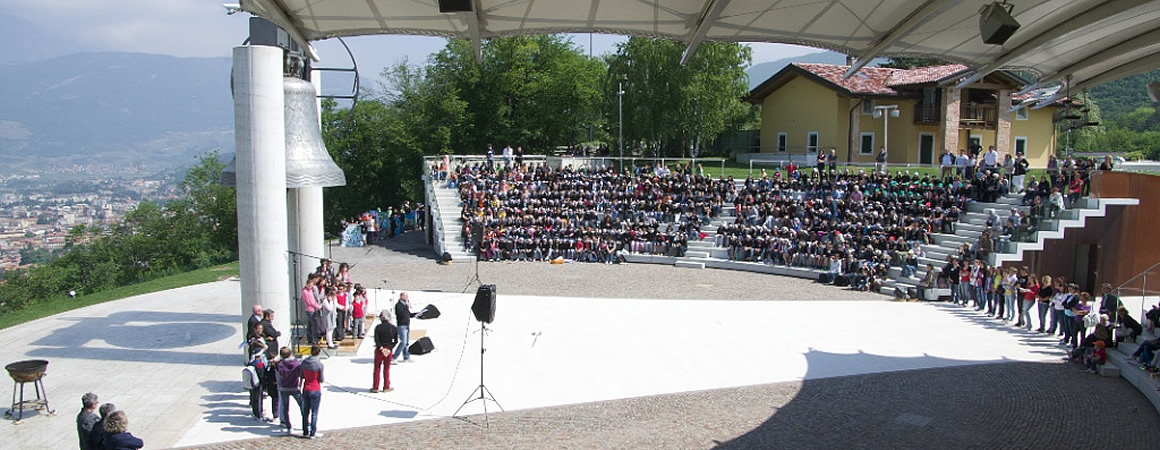THE PATH OF PEACE: route of the Pilgrimage
Evidence of the First World War can be found all over Europe: fortifications, trenches and museums, but nowhere else in the world is there anything like the Bell of the Fallen. Besides being a symbol of the tragedy of the Great War, the hundred strokes of Maria Dolens embody the message of Peace: no more war! The Bell keeps the memory alive, while looking to the future.
The “Pellegrino per la Pace” (pilgrim for peace) project is fully in line with the objectives of the Autonomous Province of Trentino in terms of valorising the area's existing heritage. As stated in the guidelines of the Trentino Great War Network, it is essential to combine skills and resources in a joint project, each partner with its own characteristics yet with a shared long-term vision.
With the restoration and valorisation project "Path of Peace", the Autonomous Province of Trento created a route 520 kilometres long, from the Tonale Pass to the Marmolada. Illustrated on the “Trentino-Grande Guerra” website, the 7 sections and 29 stages are presented as a tourist/sports trek which includes various fascinating military sites associated with the Great War (trenches, forts, bunkers etc). Considering that the Path will not be travelled only by enthusiasts of all things connected with war, but also by walkers who are open to another kind of reflection - on the subject of peace - the idea is to endow the Path with a soul, to turn it into a "secular pilgrimage" and thus offer travellers not only opportunities to observe the engineering and military aspects of the war, but also motives for meditation on the human occurrences that affected soldiers on the front line, in direct and constant contact with others defined as 'enemies' and in dramatic dialogue with the problems of human existence and the mystery of death.
From this perspective, travelling the Path of Peace - besides being a useful physical/sports exercise in its own right and bringing touristic value to the sites of the First World War - can also be a fruitful route to personal development on the subject of peace. Indeed, it is worth underlining that this Path of Peace should not be limited to the anniversary of the 1914-18 war, but rather should constitute a durable attraction, and even instigate a tradition that can be extended well beyond 2018, partly because the Path will not be travelled only by walkers interested in the events of the war, but also by many others seeking something else, something more satisfying than other routes that cover various locations in the Alps and elsewhere. Not everyone is an athlete, and the Path of Peace should not be open only as a trekking route for athletes and sportspeople. It should therefore also cater for another kind of person - as mentioned above - and offer them a route that meets their needs, over and above the motive - a positive one, though not the only one - of visiting the sites of the First World War. In this way, the Path of Peace is seen also as a "spiritual adventure" and can help travellers and pilgrims to find in nature the symbolic elements which can lead them beyond the visible world to an understanding of the mystery of life and death (in the very places where moving from one to the other could happen at any moment).
This will be both a material and a spiritual journey, and the Bell will be the landmark for Pilgrims who travel it.
A feasibility study is underway for collaboration with other entities such as mountain huts, B&Bs, restaurants and bars in order to develop the project further, and a kind of "induction" to the pilgrim route, which could take the form of establishing a Pilgrims' Guidebook, a Pilgrims' House, a Pilgrims' Passport, a Pilgrims' Menu, a Pilgrims' Anthem etc etc.
For 2014, the project is split into two sections, involving a secular pilgrimage along the Path of Peace and an event to welcome the pilgrims on their arrival at the Bell.
download the flyer for the concert
The Foundation has also established a link with the European Institute of European Routes in order to obtain official recognition of the Path as a European Route. While awaiting official accreditation, the blog made by pilgrims in the course of their journey will also be visible on the website.






